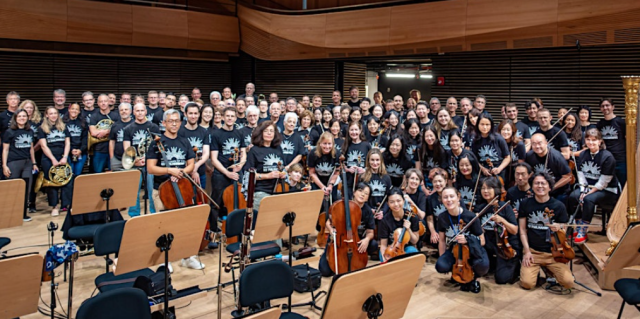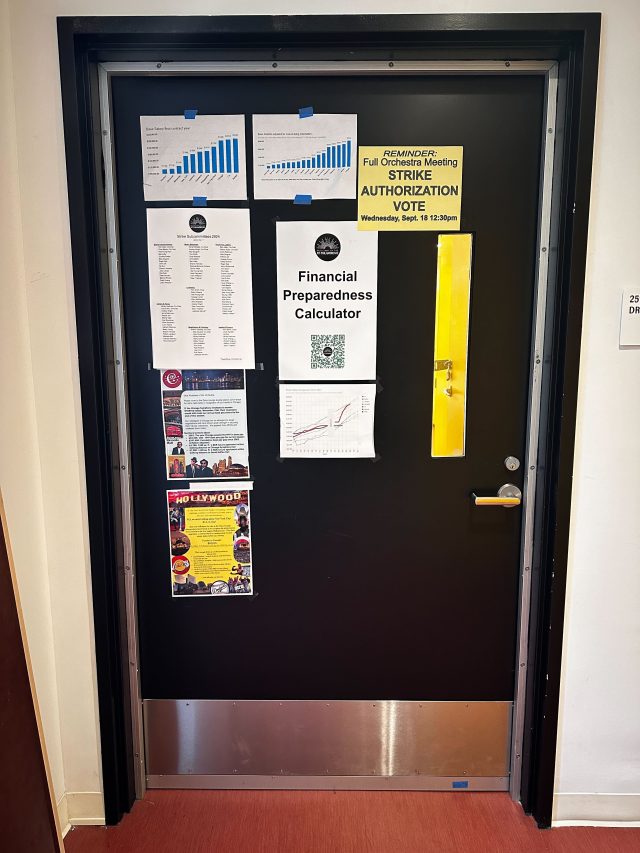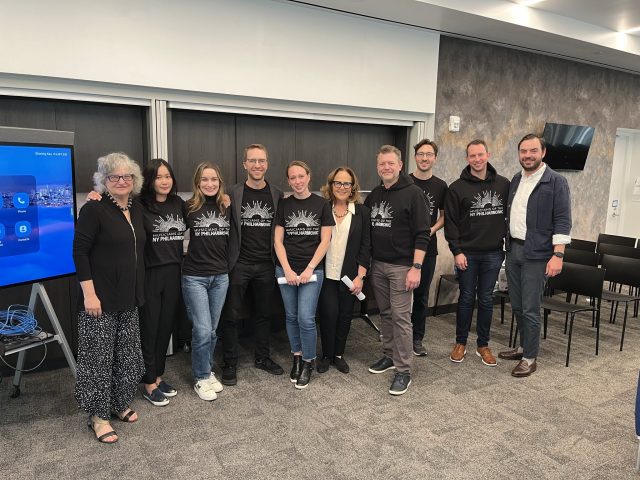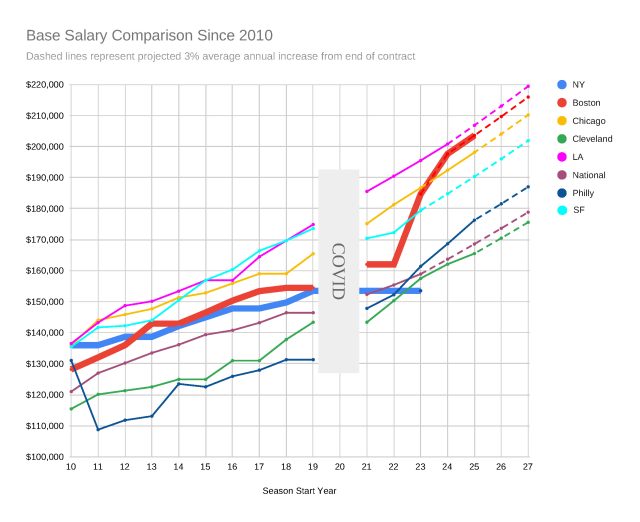Allegro
THE ROAD TO A CONTRACT
How we restored our base wage and set the stage for a brighter future
Volume 124, No. 9October, 2024

We’d like to share with our fellow musicians some of the tools and strategies we used to win our historic new contract, which grants us a restorative salary adjustment of over 30 percent and achieves other important improvements. This backstory should be helpful and inspiring to other Local 802 bargaining units who are fighting their own battles for fair contracts.
First, some history. Our expiring agreement was ratified in late fall of 2020. We were one of the unlucky bargaining units who had to negotiate before Covid vaccines were available and during peak uncertainty for the arts. The concessions necessitated by that contract — particularly in terms of salary — were severe, and meant that we started this round of negotiations with a base wage unchanged since 2019. Our former peer orchestras had left us far behind — Chicago, L.A. Phil, and Boston were all about 30 percent ahead in terms of salary. In spite of living in the most expensive city in the world, our pay was eighth best among U.S. orchestras. When adjusted for cost of living, that ranking fell to 16th. Our members had been feeling the financial strains of finding housing, commuting, raising a family, and balancing outside work such as teaching for many years. It was clear from the beginning that the major task for this committee would be restoring wages to levels commensurate with the New York Philharmonic’s place in the orchestral world.
RESEARCH & DATA PREP
We got to work immediately after we were elected: digging into the NY Phil’s institutional history and our past contracts, reading peer orchestra CBAs, and studying ICSOM settlement bulletins.
This committee was unique in that aside from two members who had previously served on one negotiating committee each, we were all first-timers in this process. While the reality was that some in management might have underestimated us based on lack of experience, we also knew we had been elected to serve because our orchestra was eager for a fresh approach to this process. We also had the benefit of an experienced and savvy support system in Local 802, including President Sara Cutler and attorney Susan Davis. We understood the stakes were high for our members and we approached this negotiation with ambition and audacity.
INFORMING & ACTIVATING OUR MEMBERS
We shared tons of data with our colleagues, including from the sources referenced above, but most effectively in the form of custom-made charts and graphs. Bassist and committee member Isaac Trapkus proved extremely adept at generating powerful visualizations of data. We created numerous charts and got creative as far as how to visually represent our stagnant wages and benefits and show the impact of NYC’s cost of living. The most famous of these was “The Boston Chart,” as it came to be known. It illustrated the non-competitive trajectory we were on and also showed what it looked like when an orchestra (such as the BSO) made a big move to reset — a wage correction, one could say, which is what we hoped to achieve with this contract. (See image below or click here to download a high-resolution PDF.)
Sharing this information was crucial. Backstage at Geffen, there are numerous musician dressing rooms which everyone including management and staff passes coming in from the stage door. We used our dressing room doors as bulletin boards to make sure our messages were reaching not only our musicians but the folks “upstairs.”

SURVEYS
We conducted numerous surveys of the full orchestra and followed up/reported out at meetings, which allowed us to accurately gather data about our priorities as a bargaining unit. Survey topics ranged from ranking financial and benefit priorities, which work conditions were the biggest pain points, how members were utilizing their health benefits, and we even got quite personal and asked people to share comments on the impact of the static base wage on their work-life balance and necessity of taking on outside work (including considering leaving altogether for other institutions). In doing so, we were able to fully capture the emotional importance of this negotiation for our members AND then show the data to back that up.
Local 802 President Sara Cutler was a constant presence and offered strong support throughout the negotiation process. Early on, we were grateful for her work to secure actuaries to analyze our pension and healthcare plans, and develop appropriate proposals and arm us for the conversations ahead.
CONSISTENT MESSAGING
We dove into everything we were hearing and documenting on behalf of our membership and an obvious narrative began to emerge. The Philharmonic had a brand-new state-of-the-art hall, had recruited the world’s most in-demand conductor to be its next music director and had a large governing board which prized itself on being stacked with business and arts industry luminaries. We also knew that our ticket sales were ahead of projections and ahead of nationwide trends in terms of post-pandemic recovery. The New York Philharmonic was clearly positioning itself as the industry leader, but the wages and benefits paid to its musicians meant we were no longer a top-tier orchestra. This became our overarching narrative: given our orchestra was, by all other metrics, “number one” in the country, it was time to reinvest in the musicians themselves and deliver an industry-leading settlement.
We developed a comprehensive proposal including a competitive — and ambitious — wage proposal and a long-overdue increase in pension. We proposed numerous work rule changes to address the fact that our weekly schedule had become increasingly erratic, with little predictable time off and too many last-minute changes, all of which was putting our members at risk for overuse injury and creating untenable strain in work-life balance. We also tackled issues like visa assistance for new members, enforceable onstage temperature requirements, improved touring language, and periodic access to an on-site physical therapist.
To accompany our proposal, we developed a 45-minute PowerPoint presentation with many of our charts and survey results as the slides. We told the story in both emotional and informational terms of how we came to be so far behind our peer orchestras, how we weathered the pandemic through mutual sacrifice, and how our members were now deserving of a contract to make good on the promises of a better future for the entire institution.
COLLECTIVE BUY-IN
One major piece of context we kept in mind during our preparations was that the NY Phil musicians had not been on strike since 1973. We were aware that our management probably considered our bargaining unit unlikely to be ready for a strike or be willing to push our leverage that far. We sought to send a different message in this negotiation, and our membership responded with levels of engagement that shattered the norm. No one in the orchestra could recall a previous time when the musicians were as united, active, and outspoken as we were in the months leading up to the negotiations.
We celebrated “peer orchestra days,” essentially calculating how many fewer weeks our colleagues in other orchestras could work in a season and still earn our base salary, marking those imagined start dates in our calendar. Boston Cream donuts from Dunkin’ at intermission for Boston Day; UNO’s deep-dish pizza at lunch between rehearsals for Chicago Day; and a beautiful cake featuring the Hollywood sign baked by our own violinist Sharon Yamada to celebrate L.A. Day — all were occasions to get our orchestra together and talking, and were a tongue-in-cheek way to humorously bring attention to the very serious issue of falling so far behind the industry standard.
In November 2023, the musicians voted to establish a Strike Fund and authorized a $50 weekly payroll contribution. That not only meant that we would approach the end of our contract with more than $175,000 in a warchest, but that management would be seeing our readiness for action with every paycheck.
We ordered “Musicians of the NY Philharmonic” T-shirts, hoodies, stickers, and buttons, and our logo became a familiar symbol. We incorporated the logo into our dressing room door signage, and musicians purchased extra apparel for family members and friends. We built an online savings calculator which allowed musicians to estimate their monthly expenses and needed savings to weather work stoppages of various lengths.
A very significant step we took at the advice of our lawyer, Susan Davis, was to have the full orchestra Zoom into the opening negotiation session. On April 5, 2024, with all our colleagues watching, we gave our narrative presentation and accompanying PowerPoint, summarizing all the data we had gathered and making our case for a restorative contract to bring us back to the top of the field. Management also delivered opening remarks and a financial presentation with the full orchestra watching. While specific proposals and subsequent bargaining took place in confidential closed sessions, it was an important measure of accountability to our bargaining unit to show the strength of our priorities and guiding principles from the outset of negotiations. It was an unprecedented step to take but it resulted in our membership feeling unified and empowered.
DISRUPTION
In spite of our efforts, the first proposal we received from management did nothing to meaningfully address any of the concerns we laid out. Then, just a week after our first meeting at the table, the New York Magazine/Vulture article “A Hidden Sexual-Assault Scandal at the New York Philharmonic” was published. Negotiations were abandoned for all intents and purposes as the institution found itself in crisis, in many ways yet to be resolved. In mid-July, without warning, Gary Ginstling abruptly resigned his position as CEO. The pervasive uncertainty provided even greater impetus for the negotiating committee to secure a contract that would make meaningful gains on behalf of our membership. At a time when musicians felt unheard and unseen, and amidst an industry-wide discourse on institutional power imbalances, we felt our argument for investing in our base wage and pushing to ensure the financial security of the most vulnerable within our bargaining unit took on greater significance.
We were fortunate that the interim management team quickly established after Ginstling’s departure shared many of our concerns, and ultimately believed as we did that investment in the orchestra was necessary and appropriate. Meetings during the summer season with Board co-chairs Peter May and Oscar Tang demonstrated a mutual desire for collaboration and furthered a positive relationship between the Board and the orchestra. Deborah Borda returned to lead the institution during this transitional time, and her presence indicated to many that the vision of building back at the Philharmonic could still be achieved. The parties agreed to resume negotiations in early September, just two weeks before the expiration of the existing agreement. We also enlisted the assistance of mediator Joshua Flax, the expert-in-residence at MIT’s Center for Constructive Communication who served 20 years as a U.S. federal mediator, for the second week of scheduled bargaining.
CONSTRUCTIVE “SMALL GROUP” WORK
Given the compressed timeframe to reach a deal, the committee spent most of August working towards consensus on the non-monetary work rules within our proposal. Very late in the game, it was indicated by management that a salary agreement would not be reached without adding a proposal to update our existing audition and tenure guidelines. We worked collaboratively with NY Phil staff, notably Personnel Manager DeAnne Eisch, to devise a comprehensive approach to these important processes. We put in long hours on Zoom to codify existing practices into proposal language and to conduct an exhaustive survey of other orchestras to devise a new framework for audition and tenure processes that is confidential, supportive, as free from bias as possible, and democratic for all participants. We’ll now take this framework to the full orchestra to be workshopped and revised over the next season, with input from management and incoming Music Director Dudamel, and we also plan to consult with representatives from the Sphinx Organization, Black Orchestral Network and the National Alliance for Audition Support.
FINAL CRESCENDO TO A DEAL
We came back from our summer break with two weeks of rehearsals and concerts before our contract expired on Sept. 20, 2024, and our members threw themselves fully into demonstrating solidarity and resolve. It was a crescendo of collective action: We elected strike-related subcommittees and saw over half the orchestra volunteer to serve on working groups handling media response and social media, leafleting, community concert prep, picketing prep, and board outreach and supporter thank-yous. Dan Point of Local 802 was instrumental in providing resources and expertise for our mobilization efforts. We wore logo-emblazoned t-shirts to rehearsals and buttons with our concert black. We brought on PR consultant Randy Whatley to refine our public-facing messaging and train musician spokespeople. We leafleted our first concerts of the season and, with smiles and warmth, expressed our genuine gratitude to our audiences for their support while also informing them of our ongoing negotiations and the necessity of fighting for improvements. We scheduled a strike authorization vote for two days before the contract expiration date, which became a significant pressure point for the maneuvers at the bargaining table.
Negotiations were intense but respectful throughout. The hours at the table were long, but over seven days there was steady progress towards a deal. It is hard to quantify what impact our year of mobilization had on the ultimate outcome, but there can be no question that the committee came to each negotiation session extraordinarily well-prepared, and when we spoke of the impact of what we were fighting for, our positions were backed up by the very visible engagement of the full orchestra. Our solidarity as a bargaining unit, our preparedness to weather a work stoppage, and the undeniable reams of data we had at our disposal all gave us credibility and strength at the table. Local 802 President Sara Cutler and attorney Susan Davis were invaluable with their help navigating towards an agreement.
On Sept.17, late in the evening the day before the orchestra was scheduled to hold its strike authorization vote, we arrived at a last, best, and final offer from management that we felt we could unanimously recommend to the full orchestra for ratification. It included over a 30 percent base wage increase over three years, with a 15 percent increase in the first year alone. It raised our pension benefit from $72,000 to $81,000, effective in the third year of the contract. And it included numerous improvements to working conditions such as increasing the number of consecutive days off, minimum guaranteed relief weeks, a “personal day” system, advanced notice of instrumentation and scheduling, visa assistance, temperature regulations, stronger tour language, access to a physical therapist, and others. The new agreement does not contain a single concessionary work rule.
This contract will make a tangible and immediate difference in the lives of our members, but we are also aware that these wage gains still struggle to keep up with inflation and NYC’s crushing cost of living. To quote our colleagues at Boston Symphony after their latest contract, “To accept less would have put the musicians in the difficult position of subsidizing the organization.”
We hope this agreement will provide a boost to other bargaining units and send a message that musicians deserve to be valued and to work under strong contracts that protect their interests. We are grateful to the management and Board of the Philharmonic for recognizing the value in our contract settlement. But above all, we thank our steadfast members and union family for their solidarity which propelled us to a deal we can all take great pride in!
POSTSCRIPT
Our joint Instagram post with Local 802 was one of the union’s most popular posts in 2024. (The union also posted it on their TikTok and Facebook.) Keep following us for more inspiration and solidarity!
The New York Philharmonic musicians’ negotiating committee included:
Ethan Bensdorf
Leah Ferguson
Dasol Jeong
Leelanee Sterrett
Isaac Trapkus
Nathan Vickery
Colin Williams


